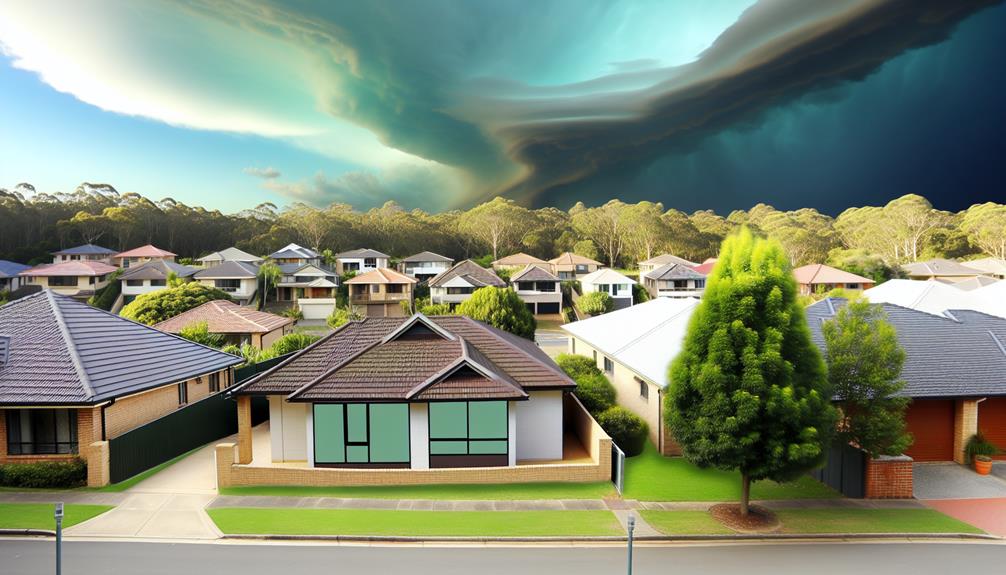When it comes to protecting your home, thorough insurance coverage for natural disasters is something you can't overlook. While standard policies cover common risks like fire and theft, they often fall short when it comes to catastrophic events like floods or earthquakes. You might think your home is safe, but have you checked your policy lately? Understanding the nuances of your coverage can make a significant difference in your financial security during a disaster. What's more, there are steps you can take to guarantee you're fully prepared, and that's where things get interesting.
Key Takeaways
- Homeowners insurance typically covers natural disasters like tornadoes, lightning strikes, and winter storm damage, but specifics vary by policy.
- Flood and earthquake damages are usually excluded from standard policies, requiring separate coverage or endorsements.
- Regularly review your homeowners insurance to ensure protection against local risks and to address any policy changes.
- Maintain a home inventory and document damages to streamline the claims process after a disaster occurs.
- Proactive home maintenance, like roof inspections and plumbing checks, enhances resilience against natural disasters and can prevent costly damages.
Overview of Homeowners Insurance
When you own a home, understanding homeowners insurance is vital, especially since it safeguards you against a variety of potential disasters. A homeowners insurance policy typically provides coverage for numerous disasters, including both natural events like tornadoes and man-made incidents such as vandalism. However, the specifics of what's covered can vary considerably based on your chosen policy. This makes it important to review your individual policy for the covered perils, so you know exactly what protections you have in place.
Commonly included disasters in homeowners insurance range from fire and smoke damage to theft protection and even volcanic eruptions. By understanding the details of your homeowners insurance policy, you gain peace of mind, knowing you're adequately protected against financial losses from these disasters.
It's important to remember that not all disasters are covered under standard policies. For instance, damages caused by floods or earthquakes often require separate insurance policies or endorsements. So, take the time to assess your coverage needs to guarantee you're fully protected against the unexpected.
Commonly Covered Disasters
Many homeowners may be surprised to learn that their insurance policies cover a wide range of disasters. Standard homeowners policies cover damage from natural events like tornadoes, lightning strikes, and even volcanic eruptions. This insurance coverage provides essential financial protection against these unexpected occurrences.
In addition to natural disasters, your home insurance policy typically includes protection from man-made incidents. For instance, smoke damage, vandalism, malicious mischief, and theft are all covered by homeowners. You'll also find coverage for damage caused by falling objects, such as tree branches, which helps alleviate the burden of unexpected repair costs.
During winter storms, the weight of ice, snow, or sleet can cause significant structural damage. Luckily, this is often included in standard homeowners policies, ensuring you're protected when the weather takes a turn. Furthermore, the accidental discharge or overflow of water from appliances, as well as sudden and accidental damage from heating systems, are commonly covered under homeowners insurance.
Additional Covered Events
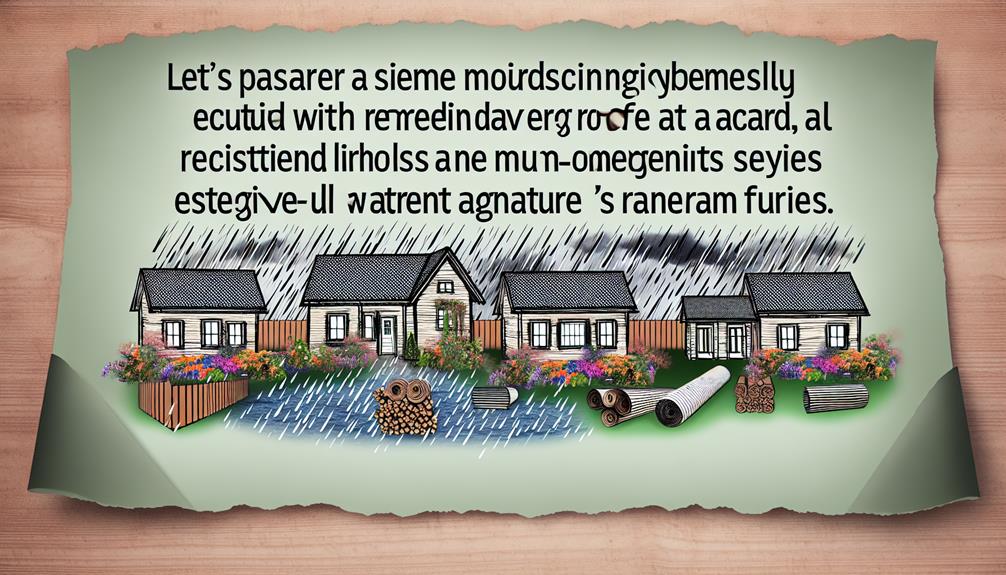
Homeowners insurance goes beyond the basics, often covering additional events that can catch you off guard. These aspects of your homeowners policies can greatly affect your protection against various risks, particularly during harsh weather conditions.
| Covered Events | Description |
|---|---|
| Weight of Ice, Snow, or Sleet | Coverage for structural failures due to severe winter weather. |
| Accidental Water Discharge | Protects against leaks from appliances, mitigating damage. |
| Heating System Damage | Covers sudden and accidental damage caused by heating systems. |
| Electrical Surges | Typically includes damage from artificially generated electrical current. |
When you review your insurance policies, it's crucial to understand these additional covered events. They can provide peace of mind, especially during winter months when freezing plumbing or heating systems can lead to costly repairs. Also, be aware that while many scenarios are covered, some specific components might be excluded, so it's wise to check your policy thoroughly. This way, you'll know exactly how your coverage can help you during unexpected situations, ensuring you're prepared for any natural disaster.
Exclusions in Home Insurance
Understanding the exclusions in your home insurance policy is vital for effective risk management. Many homeowners don't realize that standard homeowners policies typically exclude coverage for flood damage. If you live in a flood-prone area, you'll need a separate policy for sufficient protection. Similarly, earthquake damage isn't covered under most standard policies, requiring you to obtain a separate policy or endorsement.
It's also important to note that damage resulting from lack of maintenance, such as wear and tear, is explicitly excluded. This means if you neglect necessary repairs, your homeowners policy won't cover the consequences. Additionally, sewer backups are generally not included in standard coverage, making it wise to reflect on additional options for this risk.
Exclusions and limitations can vary considerably by policy, so it's imperative to review your documents closely. By understanding these exclusions, you can better prepare for potential risks and guarantee you have the needed coverage. Always consult with your insurance provider to clarify what's excluded and explore options to fill any gaps in your protection.
Understanding Natural Disaster Insurance
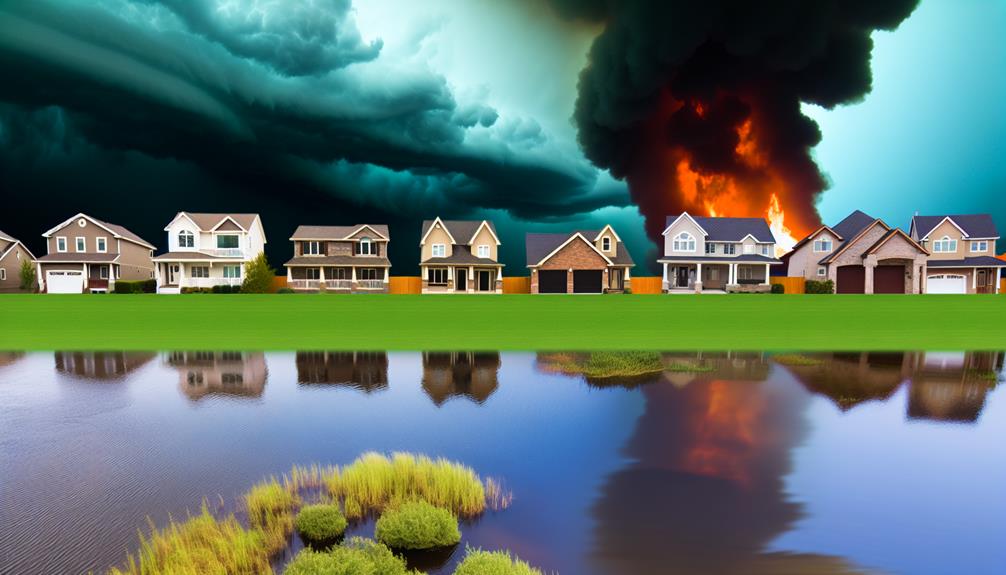
How well do you know your home insurance coverage when it comes to natural disasters? Understanding your policy is vital, as not all homeowners insurance covers every potential peril. Here's what you need to keep in mind:
- Standard Coverage: Your policy typically covers damages from fire, lightning, tornadoes, and vandalism, but always verify the specific perils included.
- Flood Insurance: Flood damage is often excluded from standard coverage, so you may need a separate flood insurance policy through the National Flood Insurance Program (NFIP) or private insurers.
- Earthquake Coverage: Standard homeowners insurance doesn't cover earthquake damage; you'll require a separate policy or endorsement, which can average around $850 annually.
- Falling Objects: While your policy may cover damage from falling objects like tree branches, exclusions could apply based on local risks.
Each homeowner's situation is unique, so reviewing your insurance policy regularly is key. Ensuring you have adequate coverage for evolving risks can help prevent the nightmare of underinsurance when disaster strikes.
Importance of Reviewing Policies
A regular review of your homeowners insurance policy is vital for guaranteeing you're adequately protected against natural disasters. By understanding the specifics of your policy, you can identify covered perils and exclusions, which helps you avoid being underinsured during an event. Policies can change over time due to updates in coverage options or changes in your home's value. That's why periodic reviews are essential to maintain adequate protection.
Consider local risks, such as flooding or earthquakes, when you assess your policy. These factors might necessitate additional endorsements or separate policies to secure thorough coverage. It's important to keep the lines of communication open with your insurance agent or company. They can provide valuable insights into additional coverage options that cater to your evolving needs and risks.
Resources for Disaster Preparedness
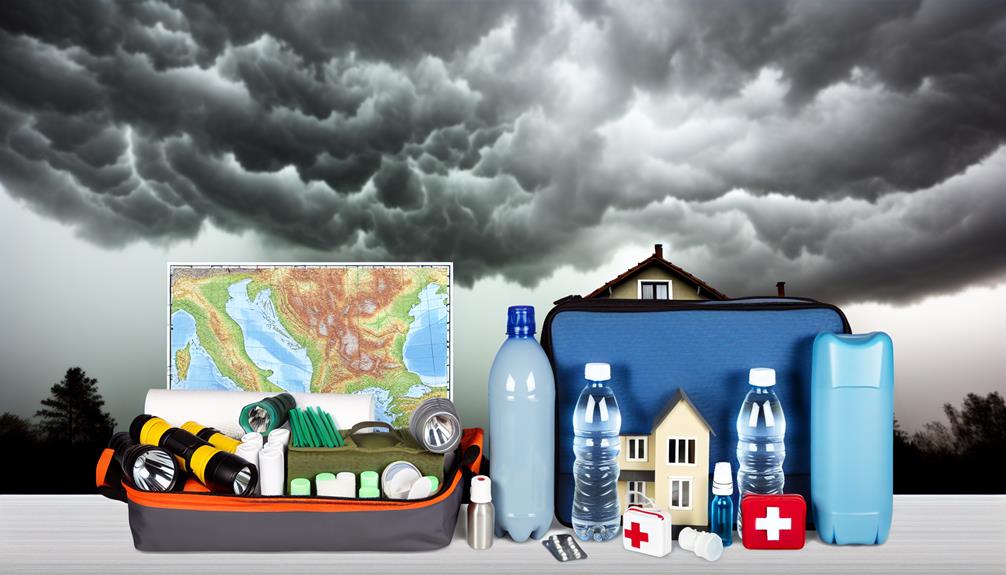
Having the right resources for disaster preparedness can make all the difference when facing natural disasters. You need to be proactive in protecting your home and belongings. Here are some essential resources to help you prepare:
- National Flood Insurance Program (NFIP): This FEMA-managed program offers separate flood insurance policies that can cover up to $250,000 for your dwelling and $100,000 for personal contents.
- Earthquake Preparedness Guides: FEMA provides valuable insurance information and resources about securing separate earthquake coverage, especially if you live in risk-prone areas.
- Home Inventory: Keep an updated inventory of your home's contents. Documenting your belongings and their values can greatly expedite the claims process during a disaster.
- Local Emergency Management Agencies: Reach out to community programs that offer resources for disaster preparedness. These agencies can provide guidance tailored to your specific local risks.
Regularly reviewing your policies cover evolving threats is vital. Don't wait for a disaster to strike—take these steps now to make sure your home is ready for whatever nature throws your way.
Claims Process After a Disaster
After you've taken steps to prepare for a disaster, knowing how to navigate the claims process is essential once the event occurs. First, notify your insurance provider immediately to discuss your policies and coverage options, including coverage for wind damage. Document all damages by capturing photographs and noting details like the type of damage, estimated value, and purchase dates.
Maintaining a claim journal can streamline the process. Organize receipts, photos, and communication regarding your claim to reduce confusion. Remember to keep all receipts related to temporary living arrangements, as these may be reimbursable under your policy for additional living expenses.
Here's a quick reference table to guide you through the claims process:
| Step | Action |
|---|---|
| 1. Notify your insurer | Contact your insurance provider ASAP |
| 2. Document damage | Take photos and note damage details |
| 3. File a claim | Confirm deadlines and required documents |
| 4. Track expenses | Keep receipts for temporary living costs |
Tips for Securing Additional Coverage
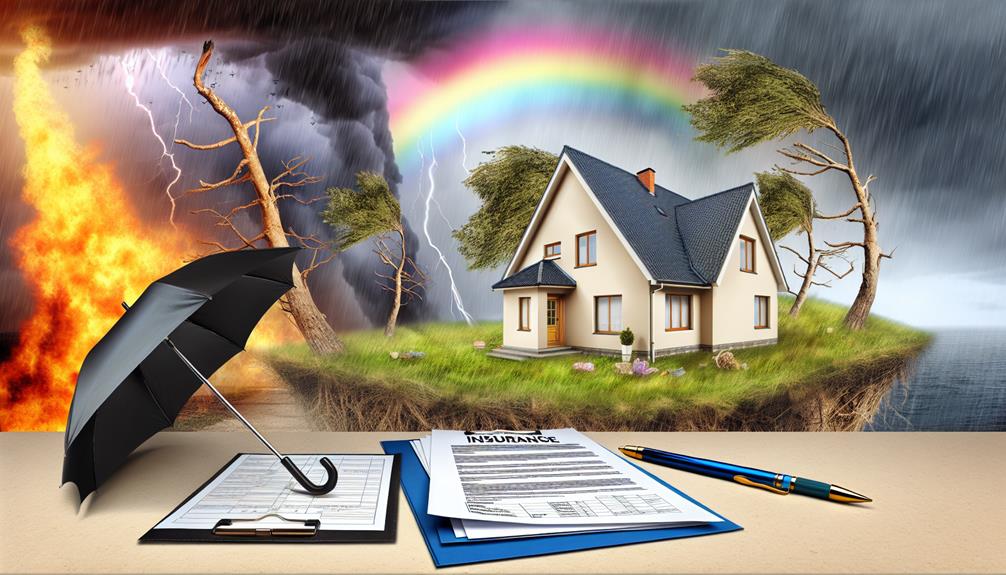
Natural disasters can strike unexpectedly, and securing the right coverage is essential for protecting your home and belongings. Here are some tips to help you secure additional coverage:
- Consider flood insurance: Standard homeowners insurance doesn't cover flood damage. Invest in a separate flood insurance policy, which averages about $859 annually through the National Flood Insurance Program (NFIP).
- Explore earthquake insurance: If you live in a high-risk area, look into earthquake insurance as it typically requires a separate policy. On average, this coverage costs around $850 per year.
- Review your policy for endorsements: Check your homeowners insurance for potential endorsements that provide extra coverage for specific perils. For instance, sewer backup insurance is often excluded from standard policies.
- Consult with insurance companies: Speak with a Farmers Insurance agent to assess your unique risks and determine what type of coverage you may need based on local natural disaster threats.
Maintaining Your Home for Safety
To protect your home from the impacts of natural disasters, regular maintenance plays a key role in guaranteeing safety and minimizing potential damage. By taking proactive steps, you can greatly reduce the risk of costly repairs and enhance your home's resilience against storm damage.
| Maintenance Task | Purpose |
|---|---|
| Inspect Roof & Gutters | Prevents water damage from rain/snow |
| Trim Trees | Reduces risks from falling branches |
| Check Plumbing | Prevents sudden leaks covered by insurance |
| Seal Foundation Cracks | Protects against flooding and water intrusion |
Don't underestimate the importance of these tasks. Homeowners and renters alike should regularly inspect their properties. Guarantee proper drainage to avoid flood issues, especially if you're in an area covered by the flood insurance program. Also, maintain your heating systems to prevent freezing pipes, which are often covered under standard home insurance policies.
Taking these steps not only helps protect your home but also gives you peace of mind knowing you're minimizing potential risks. Regular upkeep is essential for safeguarding your investment and guaranteeing your family's safety during unpredictable weather events.
Frequently Asked Questions
Do Home Insurances Cover Natural Disasters?
Home insurance typically covers various natural disasters like fire, lightning, and tornadoes, but it usually excludes flood and earthquake damage. You'll need to purchase separate policies for those risks. It's important to check your policy details because some perils, like falling objects or smoke damage, are included, while others aren't. Regularly reviewing your coverage guarantees you're protected against the specific natural disasters that could impact your home and finances.
What Type of Insurance Should I Consider if I Live in an Area Where Natural Disasters Can Occur?
If you live in an area prone to natural disasters, you should consider additional insurance policies beyond standard homeowners coverage. Look into flood insurance if you're in a flood zone, and earthquake insurance if you're in a seismic area. Verify if your homeowners policy covers wind and hail damage, especially in coastal regions. You might also want to purchase separate policies for specific risks, ensuring you're fully protected against potential disasters.
Is There Such a Thing as Catastrophic Home Insurance?
Yes, there is such a thing as catastrophic home insurance. It's designed to protect you from significant financial losses due to major disasters. Typically, you'll need a separate policy, as standard homeowners insurance often doesn't cover high-risk events like earthquakes or floods. The premiums can vary based on your location and the risks involved. Make certain to review the terms and coverage limits to guarantee you're fully protected against potential disasters.
Which Two Types of Natural Disasters Are Not Normally Covered in a Homeowners Policy?
Imagine your home as a fortress, but even the strongest walls have gaps. When it comes to typical homeowners insurance, flood and earthquake damage are those sneaky gaps in your defenses. It's easy to assume your fortress is safe, but without separate flood or earthquake insurance, you could face significant losses. So, don't wait for the storm to hit—make sure you patch those gaps and protect your dwelling against nature's unpredictable forces.
